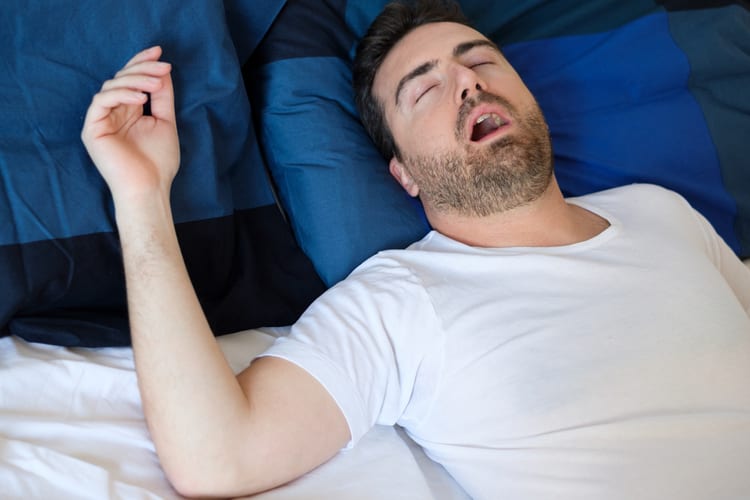Sleep Apnea: Types, Symptoms & Treatments for 2021
Sleep Apnea affects 22 million Americans, with 80% of cases undiagnosed. This sleep disorder constantly interrupts sleeping during the night as the patient gasps for breath. Sleep Apnea blocks the throat’s airway and can lead to high blood pressure and stroke if untreated. Treatment methods like CPAP can bring relief to patients by forcing the airway open with constant airflow from a mask. Luckily, modern medicine has introduced new and effective treatments which can easily be researched and found online.

Sleep Apnea: types, symptoms & treatment
Have you been feeling sleepy during the day?
Or is it the harsh snoring that wakes up your partner?
If you’re feeling any of these symptoms, you might suffer from Sleep Apnea. It’s a sleep disorder in which the person stops breathing from time to time.
In this article, you’ll learn exactly what Sleep Apnea is and its three types.
Then, you’ll learn treatment methods, such as CPAP (Continuous Positive Airway Pressure) to reduce the symptoms.
What is Sleep Apnea?
Sleep Apnea is a sleep disorder in which the person can’t go into deep sleep effectively.
Sleep Apnea happens because the pharynx (the soft tissue at the back of the throat) blocks the throat’s airway.
That means the person can’t breathe, and without oxygen, the brain sends a signal for the person to wake up - unblocking the airway.
This waking moments last milliseconds and are unnoticeable. The problem is, they prevent REM sleep, which is essential for learning and retaining memories.
In a nutshell, sleep apnea is a disorder that causes the person to wake up constantly due to a blocked throat.
There are several treatment methods, but CPAP is the most effective in results for the sleep disorder.
What are the types of Sleep Apnea?
There are three types of Sleep Apnea:
- Obstructive Sleep Apnea: this is the most common type of Sleep Apnea, when the soft tissue blocks the throat
- Central Sleep Apnea: in this case, it isn’t soft tissue that blocks the airway. Instead, the brain fails to signal the muscles that control breathing. This is a rare form of Sleep Apnea
- Complex Sleep Apnea Syndrome: the patient suffers from Obstructive and Central Sleep Apnea, with soft tissue blockage and lack of brain signal to the muscles
What are the symptoms of Sleep Apnea?
Symptoms for the three types of Sleep Apnea are similar.
Usually, patients discover Sleep Apnea when a partner notices them snoring or gasping for air during sleep. This can’t be noticed by the patient but is very obvious to others.
Here is a complete list of symptoms for Sleep Apnea:
- Loud snoring
- Gasping for air during sleep
- Interruption of breathing during sleep (only noticed by another person)
- Waking up with a dry mouth
- Waking up feeling like you just choked
- Headache in the morning
- Insomnia
- Lack of energy while awake and difficulty to focus
- Mood changes (anger issues and less sex drive)
Treatment methods for Sleep Apnea
Patients that are diagnosed for Sleep Apnea have several treatments to test.
Doctors usually recommend different methods of treatment according to the severity of the Sleep Apnea and its effects on the person’s well-being.
CPAP is the most effective treatment method and works well for most cases of the sleep disorder.
Check out a full list of treatment methods for mild and severe Sleep Apnea below:
CPAP:
CPAP stands for Continuous Positive Airway Pressure. It’s a mask placed on the patient that keeps the throat open by pushing a constant flow of air. This guarantees the pharynx stays open and allows the patient to breathe normally.
The downside with this treatment is the mask itself, which can be annoying and take time to get used to. Thankfully, there are some options of masks available to try out until the patient finds the right fit.
Oral appliances:
Dentists specialized in Sleep Apnea can mold dental devices that maintain the patient’s airway open during sleep. Some models work by pushing the jaw forward, releasing blockage from the pharynx.
Surgery:
Issues with anatomy cause some cases of Sleep Apnea. That means tonsils that are too big or even a small jaw. A deviated nasal septum can also cause Sleep Apnea.
A surgical procedure can be carried out to fix these issues that obstruct the airflow in the throat.
These are the most common types of surgery for Sleep Apnea:
- Jaw repositioning: the jaw is moved forward to create more space between the tongue and the soft palate. This avoids obstruction of the throat
- Tissue shrinkage: in this surgery, radiofrequency is used to shrink tissue at the back of the throat. Less tissue means less obstruction
- Nasal surgery: this procedure fixes a deviated nasal septum
Now, a list of treatment methods for light cases of Sleep Apnea:
- Weight loss: According to WebMD, half of the patients that suffer from Sleep Apnea are overweight or obese. In fact, according to a study shared by WebMD, 71 people with sleep apnea decreased their symptoms by shedding 16 pounds with a counseling program.
- Reduce smoking and/or alcohol: smoking and alcohol both inflame the throat, which increases the risk of Sleep Apnea. Reducing the intake of both substances can help treat this sleep disorder.
- Treat nasal allergies: these allergies can clog up the nose, and that means less oxygen intake. This can be the cause of Sleep Apnea, so doctors can prescribe a nasal spray to reduce nasal clogging.
Now you know the symptoms of Sleep Apnea and its treatment methods.
If you suspect you have the sleep disorder, please contact a medical professional immediately!
Medical help is most recommended, so you get the best treatment for your personal needs but be sure to thoroughly research the topic and treatments online as well.
Sources:
https://www.webmd.com/sleep-disorders/sleep-apnea/sleep-apnea
https://www.mayoclinic.org/diseases-conditions/sleep-apnea/diagnosis-treatment/drc-20377636
https://www.healthline.com/health/sleep-apnea/effects-on-body#1
https://en.wikipedia.org/wiki/Sleep_apnea#Mechanism
https://www.sleepapnea.org/learn/sleep-apnea-information-clinicians/

